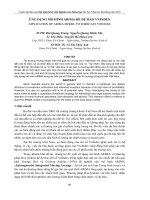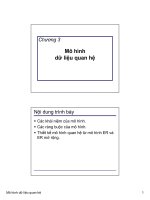03 (2)
Bạn đang xem bản rút gọn của tài liệu. Xem và tải ngay bản đầy đủ của tài liệu tại đây (1.19 MB, 45 trang )
Computer Architecture
Chapter 2: MIPS – part 3
Dr. Phạm Quốc Cường
Adapted from Computer Organization the Hardware/Software Interface – 5th
Computer Engineering – CSE – HCMUT
1
Character Data
• Byte-encoded character sets
– ASCII: 128 characters
• 95 graphic, 33 control
– Latin-1: 256 characters
• ASCII, +96 more graphic characters
• Unicode: 32-bit character set
– Used in Java, C++ wide characters, …
– Most of the world’s alphabets, plus symbols
– UTF-8, UTF-16: variable-length encodings
2
Byte/Halfword Operations
• Could use bitwise operations
• MIPS byte/halfword load/store
– String processing is a common case
lb rt, offset(rs)
lh rt, offset(rs)
– Sign extend to 32 bits in rt
lbu rt, offset(rs)
lhu rt, offset(rs)
– Zero extend to 32 bits in rt
sb rt, offset(rs)
sh rt, offset(rs)
– Store just rightmost byte/halfword
3
String Copy Example
• C code (nạve):
– Null-terminated string
void strcpy (char x[], char y[])
{ int i;
i = 0;
while ((x[i]=y[i])!='\0')
i += 1;
}
– Addresses of x, y in $a0, $a1
– i in $s0
4
32-bit Constants
• Most constants are small
– 16-bit immediate is sufficient
• For the occasional 32-bit constant
lui rt, constant
– Copies 16-bit constant to left 16 bits of rt
– Clears right 16 bits of rt to 0
lhi $s0, 61
0000 0000 0111 1101 0000 0000 0000 0000
ori $s0, $s0, 2304 0000 0000 0111 1101 0000 1001 0000 0000
6
Branch Addressing
• Branch instructions specify
– Opcode, two registers, target address
• Most branch targets are near branch
– Forward or backward
op
rs
rt
constant or address
6 bits
5 bits
5 bits
16 bits
• PC-relative addressing
– Target address = PC + offset × 4
– PC already incremented by 4 by this time
7
Jump Addressing
• Jump (j and jal) targets could be anywhere
in text segment
– Encode full address in instruction
op
address
6 bits
26 bits
• (Pseudo)Direct jump addressing
– Target address = PC31…28 : (address × 4)
8
Target Addressing Example
• Loop code from earlier example
– Assume Loop at location 80000
Loop: sll
$t1, $s3, 2
80000
0
0
19
9
4
0
add
$t1, $t1, $s6
80004
0
9
22
9
0
32
lw
$t0, 0($t1)
80008
35
9
8
0
bne
$t0, $s5, Exit 80012
5
8
21
2
19
19
1
addi $s3, $s3, 1
80016
8
j
80020
2
Exit: …
Loop
20000
80024
9
Branching Far Away
• If branch target is too far to encode with 16bit offset, assembler rewrites the code
• Example
beq $s0,$s1, L1
↓
bne $s0,$s1, L2
j L1
L2: …
10
Addressing Mode Summary
11
Synchronization
• Two processors sharing an area of memory
– P1 writes, then P2 reads
– Data race if P1 and P2 don’t synchronize
• Result depends of order of accesses
• Hardware support required
– Atomic read/write memory operation
– No other access to the location allowed between the read
and write
• Could be a single instruction
– E.g., atomic swap of register ↔ memory
– Or an atomic pair of instructions
12
Synchronization in MIPS
• Load linked: ll rt, offset(rs)
• Store conditional: sc rt, offset(rs)
– Succeeds if location not changed since the ll
• Returns 1 in rt
– Fails if location is changed
• Returns 0 in rt
• Example: atomic swap (to test/set lock variable)
try: add
ll
sc
beq
add
$t0,$zero,$s4
$t1,0($s1)
$t0,0($s1)
$t0,$zero,try
$s4,$zero,$t1
;copy exchange value
;load linked
;store conditional
;branch store fails
;put load value in $s4
13
Translation and Startup
Many compilers produce
object modules directly
Static linking
14
Assembler Pseudoinstructions
• Most assembler instructions represent
machine instructions one-to-one
• Pseudoinstructions: figments of the
assembler’s imagination
→ add $t0, $zero, $t1
blt $t0, $t1, L → slt $at, $t0, $t1
move $t0, $t1
bne $at, $zero, L
– $at (register 1): assembler temporary
15
Producing an Object Module
• Assembler (or compiler) translates program into
machine instructions
• Provides information for building a complete
program from the pieces
– Header: described contents of object module
– Text segment: translated instructions
– Static data segment: data allocated for the life of the
program
– Relocation info: for contents that depend on absolute
location of loaded program
– Symbol table: global definitions and external refs
– Debug info: for associating with source code
16
Linking Object Modules
• Produces an executable image
1.Merges segments
2.Resolve labels (determine their addresses)
3.Patch location-dependent and external refs
• Could leave location dependencies for fixing
by a relocating loader
– But with virtual memory, no need to do this
– Program can be loaded into absolute location in
virtual memory space
17
Loading a Program
• Load from image file on disk into memory
1. Read header to determine segment sizes
2. Create virtual address space
3. Copy text and initialized data into memory
• Or set page table entries so they can be faulted in
4. Set up arguments on stack
5. Initialize registers (including $sp, $fp, $gp)
6. Jump to startup routine
• Copies arguments to $a0, … and calls main
• When main returns, do exit syscall
18
Dynamic Linking
• Only link/load library procedure when it is
called
– Requires procedure code to be relocatable
– Avoids image bloat caused by static linking of all
(transitively) referenced libraries
– Automatically picks up new library versions
19
Lazy Linkage
Indirection table
Stub: Loads routine ID,
Jump to linker/loader
Linker/loader code
Dynamically
mapped code
20
Starting Java Applications
Simple portable
instruction set for
the JVM
Compiles
bytecodes of
“hot” methods
into native
code for host
machine
Interprets
bytecodes
21
C Sort Example
• Illustrates use of assembly instructions for a C
bubble sort function
• Swap procedure (leaf)
void swap(int v[], int k)
{
int temp;
temp = v[k];
v[k] = v[k+1];
v[k+1] = temp;
}
– v in $a0, k in $a1, temp in $t0
22
The Procedure Swap
swap: sll $t1, $a1, 2
# $t1 = k * 4
add $t1, $a0, $t1 # $t1 = v+(k*4)
#
(address of v[k])
lw $t0, 0($t1)
# $t0 (temp) = v[k]
lw $t2, 4($t1)
# $t2 = v[k+1]
sw $t2, 0($t1)
# v[k] = $t2 (v[k+1])
sw $t0, 4($t1)
# v[k+1] = $t0 (temp)
jr $ra
# return to calling routine
23
The Sort Procedure in C
• Non-leaf (calls swap)
void sort (int v[], int n)
{
int i, j;
for (i = 0; i < n; i += 1) {
for (j = i – 1;
j >= 0 && v[j] > v[j + 1];
j -= 1) {
swap(v,j);
}
}
}
– v in $a0, k in $a1, i in $s0, j in $s1
24
Effect of Compiler Optimization
Compiled with gcc for Pentium 4 under Linux
Relative Performance
3
Instruction count
140000
120000
2.5
100000
2
80000
1.5
60000
1
40000
0.5
20000
0
0
none
O1
O2
Clock Cycles
180000
160000
140000
120000
100000
80000
60000
40000
20000
0
none
O3
O1
O2
O3
O2
O3
CPI
2
1.5
1
0.5
0
none
O1
O2
O3
none
O1
27
Effect of Language and Algorithm
Bubblesort Relative Performance
3
2.5
2
1.5
1
0.5
0
C/none
C/O1
C/O2
C/O3
Java/int
Java/JIT
Quicksort Relative Performance
2.5
2
1.5
1
0.5
0
C/none
C/O1
C/O2
C/O3
Java/int
Java/JIT
Quicksort vs. Bubblesort Speedup
3000
2500
2000
1500
1000
500
0
C/none
C/O1
C/O2
C/O3
Java/int
Java/JIT
28









